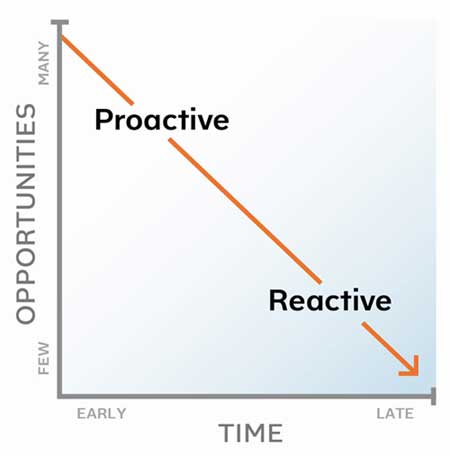Building and maintaining a strong brand require constant monitoring and nurturing.
And, on occasion, a brand strategy needs to be refined or rejuvenated—or even reset to conform to an entirely new direction by the business.
This article details the signs that indicate it may be time to re-brand your business. Usually, that time comes during one of the following three circumstances:
- When it's clear: Your company is about to undergo a Big Change.
- When it's fuzzy: The brand hasn't been evaluated in some time.
- When in a growth spurt: You're trying to just get through today and don't have a chance to think about tomorrow.
Why evaluate your brand strategy?
Because "what got you here won't get you there."
Businesses operate in dynamic environments: Customer behavior changes; technologies advance; competitor offerings, regulations, and company goals change. And that's not a bad thing.
But brands that remain static are at risk of becoming irrelevant or stagnated. And that's when bad things can happen:
- Corporate and brand strategies become misaligned.
- The organization loses its sense of purpose.
- Employees disengage.
- Culture wanes.
- Innovation stalls.
- The customer value proposition weakens.
- Customers lose interest.
Losing relevance rarely happens via a "lightning bolt" moment. It's more like slow death by a thousand paper cuts. In business, as in nature, stagnation breeds decay. Standing still is not an option.
When do you evaluate your brand strategy?
1. When it's clear
When your business is approaching a moment of Big Change, there will be brand implications. Instances include the following:
- Merger or acquisition
- Entering a new market
- When a new or aggressive competitor enters your market
- Launching a new innovation or product
- New leadership or outside investors, or both
Those situations are typically accompanied by a shift in the vision or direction of the company, with tangible impacts on business strategy. Therefore, it's optimal for the brand and business strategy to be developed simultaneously to ensure they are aligned.
2. When it's not so clear
Sometimes, it is much harder to realize "it's time."
Like the proverbial frog in the pot who doesn't notice the water is getting hotter and hotter—and then it dies—a period of time may pass until someone "wakes up" one day to find...
- Customer needs have changed.
- Macro forces and trends have shaped the landscape.
- A product portfolio has become so large or complex, or both, that it is not only hard to sell but also hard to buy.
- Your brand has been neglected, or at least not actively managed.
- Your business strategies are shifting.
- You value proposition and messaging have become "me-too."
3. You're a victim of your own success
When a company is experiencing high growth, often everyone is so enthusiastically busy trying to stay ahead of the demands of today that they don't take the time to look at tomorrow's longer road.
Evaluate early and often
A proactive approach will increase the likelihood that you'll be able to develop a strong and intentional strategy. On the flip side, delaying can force you into a reactive, time-boxed situation, which will compromise your strategy because...
- You don't have enough time to properly assess your current brand strategy and evaluate how it will serve the anticipated new conditions and environment it must perform within.
- Your ability to conduct the proper research to gather the necessary information and insights for evaluation is limited.
- Your ability to explore multiple options and adequate time to evaluate/assess them is limited.
- Inevitably, in reactive situations, the delayed start means a delayed "time to impact" with the new brand direction.
For example, evaluating the brand strategy of two companies as part of due diligence in a potential merger affords far more strategic options and minimizes the typical scramble and "hurry up to fix it" problems post-merger.

In business, and especially in B2B, the distinction between brand and business is synonymous in the minds of employees and customers. The B2B buyers of today demand transparency; they also demand to know the character and values of the company behind the product.
In general, the earlier you evaluate, the more time you have to optimally develop and implement your strategy. To anticipate and stay ahead of the dynamic environments in which they operate, B2B leaders should frequently and proactively evaluate their brand strategy in tandem with their business strategy.
Aligning both strategies will ensure that the brand remains relevant as well as maximize the performance and value of the business.




